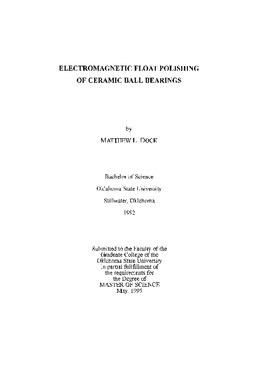| dc.description.abstract | Advanced ceramics. offer advantages over other materials in applications that require high stiffness, high temperature strength, high wear resistance, or high fatigue life. The ceramic ball bearing is a system that can operate in environments that would cause other bearings to fail. Unfomtunately, ceramic bearing elements are expensive to manufacture and require reliability in performance in service. Cost effective methods of ceramic element manufacturing are required to allow ceramic elements to be incorporated into mainstream manufacturing. Ultra-precision grinding machines can generate quality ceramic parts but this equipment can not handle spherical elements. For this reason, magnetic float polishing has been developed to lower the manufacturing cost, improve surface finish, and sphericity. Magnetic float polishing was originated from the work done on magnetic fluid grinding in Japan. The process utilizes magnetic fluid, abrasive grains, ,and a drive spindle to polish the ceramic elements. The equipment utilized In magnetic fluid grinding and magnetic float polishing is similiar to the equipment developed for magnetic abrasive finishing since the 1940's. Magnetic float polishing is a technique that requires little capital expenditure, can be incorporated on existing machine tools, and can produce quality parts that withstand the mechanical and thermal stresses associated with the operation in advanced systems. The construction of magnetic float polishing apparatus has typically been with permanent magnet systems. The electromagnetic apparatus developed here for the first time for finishing balls has promise of controlled magnetic field strength, stronger forces, and I improved polishing efficiency. An electromagnetic float polishing apparatus was desigrled and built to evaluate its perfonnance in polishing and to compare it with the permanent magnet setup. ANSYS software was then used to improve on the intial electromagnetic design called straight field design. The modified design, now called a ring pole system, has shown the ability to polish ceramic ball bearing elements and improve on the sphericity of those parts. The equipment is capable of polishing small batches of 10-20 ceramic balls in a small polishing chamber allowing small batch production. The electromagnetic polishing apparatus is capable of removing 6 um/min , allowing the apparatus to be utilized as a roughing station. During the rough polishing the average obtainable sphericity is approximately 3um obtained withing 4, hours of starting the polishing process. The same equipment can then obtain a surface roughness, Ra, of 5nm, allowing a single piece of equipment to transfonn a rough and out of shape ball into a smooth spherical element. The ceramic ball elements have been characterized to detennine the characteristics of the polishing apparatus, and the effects of polishing are catagorized. High material removal rates and and good sphericity control show the capabilities of the electromagnetic polishing apparatus and its application to future processing methods. | |
